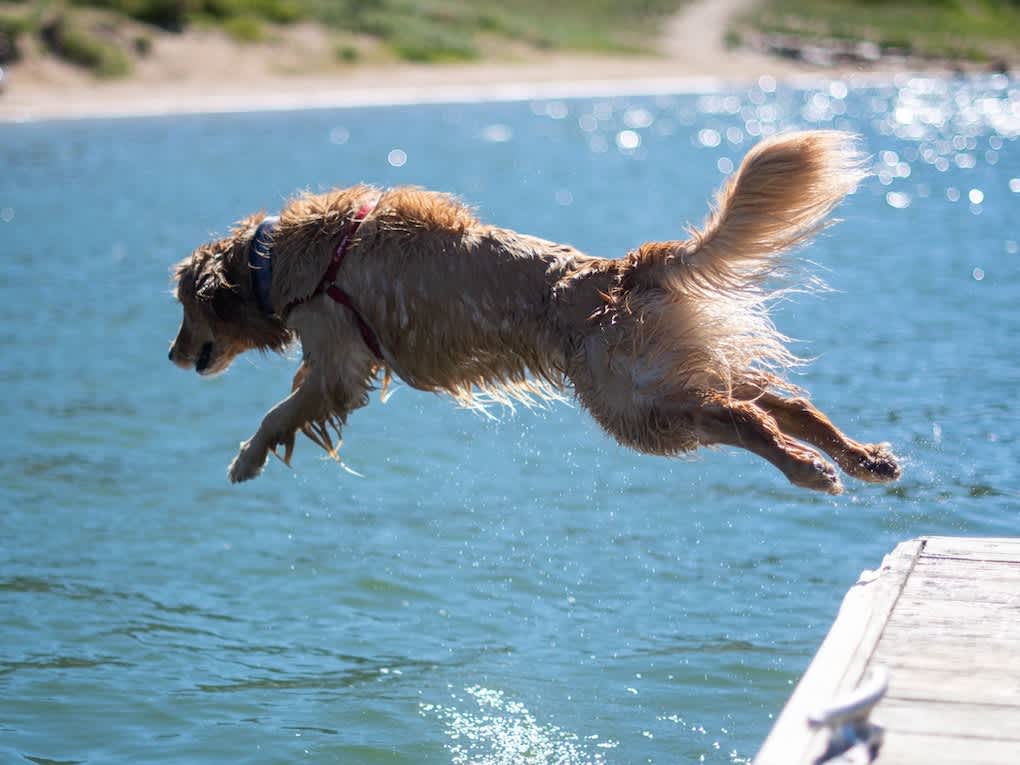Pool parties, festivals, hiking—summer is here. Those of us with dogs know that none of our summer activities would be complete without our four-legged pals. Here are a few scenarios with safety tips to help you and your dog make the most of this fun season.

Water safety
Dogs love a refreshing swim in the pool or lake, especially when a game of fetch is involved. Remember dogs will get tired while swimming, just like a human, and they don’t always have the forethought to take a break. Alleviate your worries by investing in a canine life jacket for whenever your dog is participating in water activities. Most life jackets have a strong handle, so you can easily lift your dog from the water to safety.
Food safety
A picnic with family and friends is full of delicious snacks—many of which we feed to our dogs as treats. Though fun to give, treats contain extra calories that put your dog at risk of weight gain. Additionally, some foods that are safe for humans are hazardous for dogs. For example, onions and garlic are toxic to dogs. On the other hand, some fruits make nutritious snacks for dogs. Watch out for excessive salt or fat, such as in hot dogs or hamburger grease, which can spike blood pressure and lead to pancreatitis. If you plan to treat your dog at a party, bring a cup of dog food with you to use instead of human food.
Festival safety
Be mindful of your dog’s stress level at summer festivals. Hundreds of new people and dogs can be frightening. When your dog acts concerned (excessive panting, barking, whimpering, cowering, charging), take a break from the activity. Additionally, when the sun is shining, asphalt and concrete constantly absorb energy and reach scalding temperatures. Even though your dog’s paw pads are covered with thick skin, excessive heat will still hurt and cause damage. Protect your dog’s feet by walking on grass and limiting time on pavement. Learn more about how to protect your dog’s paws this summer.
Car safety
Never leave your dog in a car unattended (even with the windows cracked open) because they’re at risk of overheating. It is heartbreaking to imagine our best friends sweltering in a hot car, and heated cars can be fatal in as little as 10 minutes. When your dog is with you, opt for drive-throughs or save shopping trips for later. Check out our tips for taking car rides with your dog.
Hiking safety
When exercising on hot days, remember dogs can over-exert themselves and develop heatstroke just like humans. Heatstroke occurs when the body’s rising temperature overwhelms its cooling mechanism. For dogs, this mechanism is panting, which uses the same principle as sweating: the evaporation of water helps cool the body down. While evaporation cools, it also leads to dehydration if your dog does not drink enough water to balance the water lost through evaporation. Evaluate how rapidly your dog is panting as your hike progresses. Be sure to take frequent breaks and offer ample fresh water throughout the hike. If you think your dog has heatstroke, get them into a cooler environment, such as a cold stream or air-conditioned car, then immediately bring your companion to the veterinarian. Heatstroke can be life-threatening, so know the signs. Be prepared when hiking with your dog.
Woods safety
In the woods, your dog encounters plants, insects, and animals, some of which are harmful. You may not be able to make the woods safer for your dog, but there are steps you can take to defend your pet. Preventative medications against fleas, ticks, and heartworm (contracted from mosquito bites) are crucial to every pet’s well-being, but especially those who explore outdoors. Ticks carry Lyme disease and many other infectious organisms that can cause disease.
You can get flea, tick, and heartworm preventatives from your veterinarian during your pet’s annual exam. Also during the exam, your vet will make sure your dog is up to date on vaccines, including rabies. Wildlife can carry the rabies virus and transmit it to your dog. If your dog chases wildlife, keep them on a leash while hiking. Walking your dog leashed will also help protect them against accidental poison ivy or poison oak exposure. With preventative measures, plus frequent water breaks, you and your dog will be unstoppable this summer.













